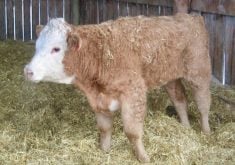The warning sign went up as results came in from two Alberta projects exploring the susceptibility of bacteria involved in bovine respiratory disease (BRD) to available antimicrobials.
Alberta Beef Producers (ABP) administered the year-long project testing for antimicrobial resistance in feedlot cattle in order to develop an in-province screening tool. The project involved several industry, research and government collaborators and was funded by the Alberta Livestock and Meat Agency (ALMA) and Growing Forward 2.
Seven veterinary clinics submitted 750 samples from feedlot cattle that had been treated for or died from BRD from October 2014 through March 2015.
Read Also

Body condition, nutrition and vaccination for brood cows
One of the remarkable events of the past century related to ranching has been the genetic evolution of brood cows….
The bacteria most frequently isolated from the samples were Mannheimia haemolytica (22.5 per cent of all isolates), Mycoplasma bovis, Pasteurella multocida, Histophilus somni, and Trueperella pyogenes. In all, 1,045 isolates were obtained and screened against 18 antimicrobials, some commonly used to treat BRD and others not, explains ABP beef production specialist Karin Schmid.
Each bug had some level of resistance to one or more antimicrobials, while four out of 223 M. haemolytica isolates showed resistance to drugs from eight classes of antimicrobials. This multi-class drug-resistance finding for M. haemolytica mirrors results from a recent study in the U.S., although it has yet to be confirmed whether the strain in the U.S. is the same as the strain in Canada.
“We expected to find some level of resistance because all of the samples were from ill animals after treatment and many after death, so all had at least one treatment, but we couldn’t get full treatment records,” Schmid notes. “The sky isn’t falling because this was a very small sample size, but we did see multi-class resistance.”
All antimicrobial use in people and animals leads to some level of resistance because antimicrobials never kill 100 per cent of the target and other bacteria. Those that survive go on to reproduce and some have the ability to pass their genes for resistance to other bacteria (Canadian Cattlemen, October 2014).
“For example, treatment with tetracycline could lead to resistance against another drug in that class or another class. It’s complex and really depends on the bug and the drug,” says Schmid.
Similar to the practice of rotating herbicides to curb the evolution of herbicide-resistance weeds, rotating antimicrobials from differing classes may be an effective way to reduce the odds of some, but not all, bacterial strains acquiring a high level of resistance to any one drug.
“The good news is the low frequency of resistance to Category I antimicrobials,” she says. Resistance levels were generally below four per cent, depending on the antimicrobial. Health Canada has 13 drug and therapy classes in this category because of their importance in human medicine.
The bug most frequently resistant to Category I drugs was M. bovis. Its unique structure, with no cell wall, makes it naturally resistant to beta-lactams including ceftiofur (Excenel). Some studies suggest M. bovis could be susceptible to the fluoroquinolones, but that didn’t prove out in this project with 93.8 per cent of M. bovis isolates showing resistance to the fluoroquinolone enrofloxacin (Baytril).
Resistance to the florfenicals (Nuflor, Resflor), a Category III (medium importance) antimicrobial, ranged from 1.3 to 30.9 per cent, indicating that it remains a feasible option for treating BRD.
Another positive outcome was that some of the clinics referred to the results of the antimicrobial susceptibilities test (AST) on samples they had submitted to select the most effective treatment options during the course of the project. The turnaround time between submitting a sample and receiving the results was 72 hours for most isolates.
The Public Health Agency of Canada runs the Canadian Integrated Program for Antimicrobial Resistance Surveillance (CIPARS) that monitors the prevalence of antimicrobial resistance in bacteria that cause disease in people, such as salmonella, E. coli, and campylobacter.
Schmid says industry officials are in the early stages of discussions to establish a regular surveillance program, possibly tied to CIPARS, to monitor antimicrobial resistance to livestock drugs. This project provided some tools that could be useful for such a service.
A fact sheet outlining the results of the project is available at www.albertabeef.org.
Test before you treat
His initial work involved screening H. somni isolates from 56 feedlot cattle diagnosed with BRD against 10 classes of commonly used antimicrobials. Treatment records weren’t available so he had no way of knowing which drugs were used on these animals.
However, 96 per cent of the H. somni isolates were resistant to at least one antibiotic, most frequently gentamicin (94 per cent), oxytetracycline (74 per cent), penicillin (50 per cent) and tylosin (40 per cent).
The high level of resistance to gentamicin was interesting as it is banned from use in feedlot cattle. Resistance may be due to co-selection, which is a genetic process of transferring two or more resistance genes together.
Seventy-three per cent of all isolates were resistant to more than one class and 34 per cent were resistant to four classes.
None of the isolates had resistance to enrofloxacin, tulathromycin and the folate pathway inhibitor trimethoprim+sulphamethoxazole. Resistance to spectinomycin, ampicillin, ceftiofur, phenicol, and florfenicol was very low (less than 10 per cent).
The resistance pattern has changed dramatically over the past 30 years, according to results just in from screening tests on 32 H. somni isolates collected in the 1980s from the tissue samples of cattle that died from BRD. These isolates were obtained from the Vaccine and Infectious Disease Organization at the University of Saskatchewan.
“For the older isolates there was no resistance to tetracyclines,” Bhatt says, adding that this was quite surprising. “In summary, the older isolates are sensitive to almost all of the antimicrobials we tested. In addition, the minimum inhibitory concentration of the older isolates is pretty low for almost all antimicrobials compared to the new isolates. This means that a very low concentration of the antimicrobial is sufficient to kill the older isolates compared to the new isolates.”
“What this means for producers and veterinarians is that things change over time in response to antimicrobial use. It is worrisome for public health and the cattle industry as well,” says project supervisor Dr. Karen Liljebjelke, assistant professor with ecosystems and public health, UCVM.
Adding to the concern is the fact that current vaccines against histophilosis are not terribly effective. This could be because of changes in the virulence (disease-causing) factors over time as observed by feedlot veterinarians in the way the disease has been presenting itself in recent years.
Bhatt’s study focuses on H. somni but any one of the bacterial pathogens associated with BRD could have been the subject. All are commonly found in cattle and never cause a problem until stress pushes the immune system over the edge and gives one or more of the pathogens an opportunity to multiply out of control. Stress adds up at each step of the way from the ranch to the home pen at a feedlot as newly weaned calves are mixed, transported and processed on arrival.
“Veterinarians and producers can only use what’s legal for drug treatment. When choosing, they must consider cost, the delivery mechanism and what’s practical, their own experience as to what’s still effective, and other regulatory issues like withdrawal times,” Liljebjelke explains.
“I really encourage regular diagnostic sampling to identify the bacteria and antimicrobial sensitivity. Economically, sampling and getting a good idea of what’s causing the problem will give you a better bang for your buck because you won’t be wasting money on drugs that aren’t going to be effective.”
This approach of sampling to identify bacteria causing illness is also being encouraged in human medicine, she adds.
Bhatt’s research, funded by ALMA, is now examining the genetic fingerprints of the new and old isolates to try to determine how the new H. somni isolates acquired this resistance over time and whether it is the same bacterial strains that have acquired resistant genes, or a whole mix of new strains from many feedlots that are building resistance. They will identify resistance genes and whether those genes can be passed to susceptible bacteria and if so, the mechanism of transmission.
Another angle will follow up on the findings from a U.S. study that found acquired genes for resistance to tetracycline along with tolerance to copper and zinc (common ingredients in feed rations) being passed on together in a single genetic package. These genetic packages seem to acquire genes over time and could end up passing multi-drug resistance in one package, which is really the big issue of the day, Liljebjelke says.

















